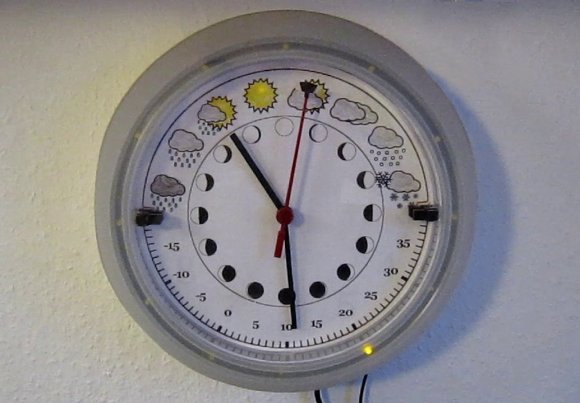
A clock to tell the weather? [Andrew] has created a device to do that and more. Inspired by [Sean’s] weather clock, [Andrew’s]clock displays the current weather conditions, temperature, moon phase, and of course the time. The whole project started years ago with a broken keyboard. [Andrew] wanted to try to use the keyboard controller PCB as a bidirectional computer interface. Data to the computer would go in via the key matrix. Output data would be read via the status LEDs. Cheap simple microcontroller boards like the Arduino sidelined the project for a few years, but he never completely left it behind.
With an unused OLPC XO-1 in hand, [Andrew] pulled out his old keyboard controller and started hacking. His first task was getting meaningful data out of the keyboard LEDs. He coded up his own keyboard led control library in python. On the hardware side an op amp took on the roll of a comparator to ensure proper logic levels were present. [Andrew] then hooked two LEDs up as clock and data lines to standard 74 series shift registers (most likely 74HC/HCT595). He found that his data was completely garbled due to bounce. A second shift register buffering the clock cleaned things up. [Andrew] was left with a stable 40 bits per second serial link to his shift registers. With all this done, the next step was the clock itself. [Andrew] bought a RUSCH Wall clock from IKEA, and converted the clockwork to a gear reduction for a DC motor he pulled from an old answering machine. He could now move the hands at will, but had no way to determine their position. IR break beam sensors from old printers came to the rescue.
After connecting the motor drive, [Andrew] still had a number of outputs available. A few LEDs were in his parts box, so into the project they went. 12 LEDs around the outside of the clock to display the current time. 3 LEDs hide behind the weather icons as status indicators. [Andrew’s] python software really ties this together. His OLPC grabs data from the internet and displays it on the clock. A web interface allows the user to perform manual updates on the clock and to set alarms. The alarms even incorporate speech output via eSpeak. We love the reuse and recycling of parts in this hack. The end result is a clock any hacker would be proud to display on their wall.















I’ve never heard of LEDs “bouncing” when they are turned on or off.
Impressive recycling. What about using the over-practiced and slightly nervous voice on the original answer machine message rather than eSpeak?
I’ll be home tonight about quarter past partly cloudy, but get the girls to bed the new moon.
Lol. I actually get that a lot, usually right after “What the hell is a weather clock?”
*role
Hell, if it was all in one I’ed buy this, except for the voice, it’s creepy!
It’s like being woken up by a Dalek. (c:
I love reading the content on this site. I have to ask however.. Does anyone else find it incredibly disturbing that he “had an unused OLPC XO-1 in hand”?? One Laptop per Child, a non-profit organization trying to get technology into the hands of kids FOR SCHOOL. Maybe the program is gone/dead and he somehow acquired it? Stats on the wiki do only cover up to 2011, but there is no mention (that I saw) of the program being dead. Just curious as people who have donated to the cause might find concerns that he never used his.. (till now, that is, but not for the reason it was given to him).
Cool hack though, for what it’s worth.
For a while, OLPC was doing a Give 1 Get 1 deal. My dad bought two of these through that program, and gave me one to play with. They are both pretty much collecting dust right now, as I haven’t had much time to play with it, and cheap rooted Nook tablets do most of what we were actually using the XO-1s for (reading books/tech docs).
Exactly right. I got my OLPC through the give1get1 program and used the hell out of it. I even traveled around the world with mine (http://outsideworld.org/comic.php?id=226) but now I also have a Nook which I love (http://hackaday.com/2012/03/16/using-the-nook-as-a-keyboard/).
OLPC is still alive and creating newer hardware. After the XO1, came the XO1.5 with a better processor and more RAM and now they have the XO1.75 with ARM processors and XO3.0 with ARM and touch support. I actually have a 1.75 XO with a “developer keyboard” (not the silicon skin original one) that I’m selling if anyone is interested…